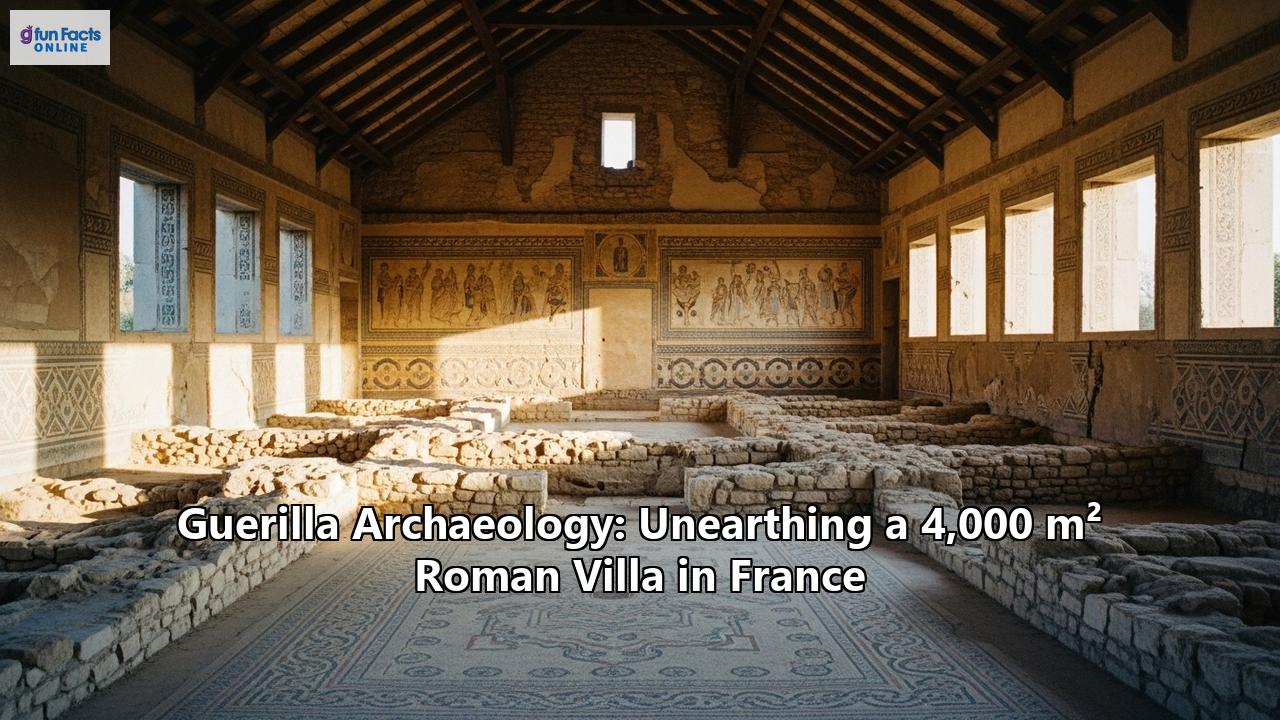In an astonishing turn of events that has captured the imagination of history enthusiasts worldwide, a monumental Roman villa, sprawling over an impressive 4,000 square meters, has been unearthed just three kilometers south of Auxerre in France's Bourgogne-Franche-Comté region. This remarkable find, one of the largest ever discovered in what was once Roman Gaul, is dramatically reshaping our understanding of the lavish lifestyles of the provincial elite during the Roman era.
The discovery was made by archaeologists from the French National Institute for Preventive Archaeological Research (Inrap) in advance of infrastructure development. The site, known as Sainte-Nitasse, had been recognized for its archaeological potential since the 19th century. However, a limited survey in 1966, prompted by the creation of a gravel pit, had only revealed a 700-square-meter rectangular building, hinting at the presence of an affluent establishment but not its true, spectacular scale.
Today, the ongoing excavations paint a far grander picture. The building uncovered in 1966 is now understood to be merely a secondary wing of an exceptionally large and luxurious residence. The villa's design is centered around a vast square garden, itself covering more than 450 square meters. Surrounding this central oasis are galleries that once led to opulent reception rooms, functional spaces, and possibly a kitchen.
One of the most stunning features of this palatial home is its private thermal baths, located in the eastern wing, complete with a hypocaust system for underfloor heating—a clear marker of the owners' wealth and high status. The structure's walls were built from a mix of rubble, fragments of funerary steles, and even pieces of columns, suggesting a complex history of construction and reuse of materials. Associated artifacts confirm the site was occupied from the 1st to the 4th centuries AD. The sheer size and features of the villa suggest it belonged to an aristocratic or high-ranking family, deeply immersed in Roman culture.
This discovery is part of a thrilling wave of recent archaeological finds across France that continue to illuminate the Gallo-Roman period. In Reims, excavations have revealed another luxurious villa, or domus, dating to the 2nd century C.E. This city, then known as Durocortorum, was the second largest in Roman Gaul. The Reims villa boasted an imposing facade with two large pillars and, inside, a wealth of treasures including finely crafted bronze statuettes and a rare fresco depicting a myth of the hero Achilles. The quality of these finds points to a wealthy owner with strong ties to Roman cultural traditions.
Further demonstrating the richness of Roman-era discoveries, excavations in Soissons, near a significant ancient road, uncovered a villa with a classic layout featuring an internal courtyard surrounded by a long boundary wall. This site yielded items related to both domestic life and agriculture, such as tools, coins, and structures that may have been ovens or a forge. Interestingly, this site also held a much later grave of a man buried with personal items including a silver cross rosary and a Swiss army knife, adding a mysterious layer to its history.
Meanwhile, in Avranches, Normandy, the unearthing of the Roman outpost of Legedia has revealed the ruins of a lavish urban home with private baths and remnants of vibrant red, green, and yellow frescoes. The presence of imported limestone for administrative buildings and fragments of a large column that likely supported a public monument further attest to the area's importance.
These discoveries, often made possible by what is sometimes termed "guerilla archaeology"—salvage or preventative excavations conducted ahead of modern construction projects—are crucial. They provide an invaluable, and often fleeting, opportunity to piece together the daily lives, architectural tastes, and economic activities of the inhabitants of Roman Gaul. From the grand agricultural estates like the one in Auxerre to the sophisticated urban residences of Reims and Avranches, each new find adds another fascinating chapter to the story of Roman France, revealing a landscape dotted with centers of wealth, culture, and power.
Reference:
- https://www.labrujulaverde.com/en/2025/06/spectacular-4000-square-meter-roman-villa-discovered-in-france-one-of-the-largest-in-gaul/
- https://www.lefigaro.fr/sciences/a-auxerre-une-gigantesque-villa-romaine-decouverte-dans-un-etat-de-conservation-exceptionnel-20250604
- https://arkeonews.net/one-of-gauls-largest-roman-villas-discovered-near-auxerre-france-spanning-over-4000-m%C2%B2/
- https://arkeonews.net/tag/roman-villa-auxerre/
- https://www.inrap.fr/une-grande-villa-antique-auxerre-yonne-20067
- https://allthatsinteresting.com/reims-france-roman-villa
- https://news.artnet.com/art-world/roman-villa-reims-bronze-statuettes-2584386
- https://research.cardiff.ac.uk/converis/portal/list;jsessionid=WPqH2Q2EBm-tfdHL9DCl2uEHTtHsiY60qofeuob6.cu?show=Project&filter=%5Bforganisation%3D458736%5D%2C%5Bfarea%3D%5D&sortBy=cfstartdate&sortOrder=false&cypher=All&page=1&items=100&showAll=&treeView=false&moreOrLess=%5Bforganisation%3Dfalse%5D%2C%5Bfarea%3Dfalse%5D&lang=en_GB

